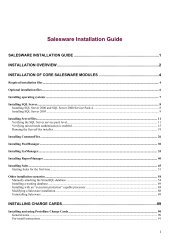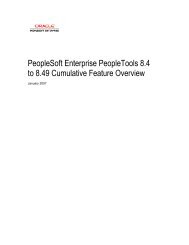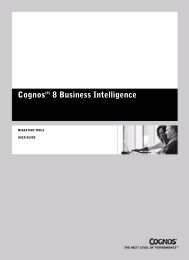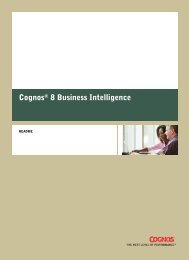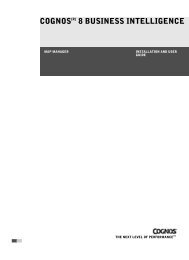Cognos ReportNetTM Installation and Configuration Guide
Cognos ReportNetTM Installation and Configuration Guide
Cognos ReportNetTM Installation and Configuration Guide
Create successful ePaper yourself
Turn your PDF publications into a flip-book with our unique Google optimized e-Paper software.
Chapter 4: Configuring ReportNet<br />
Steps<br />
1. On each computer where Content Manager or the report server is installed, start <strong>Cognos</strong><br />
<strong>Configuration</strong>.<br />
2. In the Explorer window, under Data Access, click Notification.<br />
3. In the Properties window, for the SMTP mail server property, type the host name <strong>and</strong> port<br />
of your SMTP (outgoing) mail server.<br />
4. Click the Value box next to the Account <strong>and</strong> password property <strong>and</strong> then click the edit<br />
button when it appears.<br />
5. Type the appropriate values in the Enter the user ID <strong>and</strong> password dialog box <strong>and</strong> then<br />
click OK.<br />
6. In the Properties window, type the appropriate value for the default sender account.<br />
7. From the File menu, click Save.<br />
Configuring Web Browsers<br />
ReportNet uses the default browser configurations provided by Netscape <strong>and</strong> Microsoft. To<br />
ensure that <strong>Cognos</strong> Connection <strong>and</strong> Query Studio operate effectively, an administrator should<br />
ensure the following settings are enabled:<br />
• Allow Cookies (Internet Explorer <strong>and</strong> Netscape Navigator)<br />
• JavaScript (Netscape Navigator)<br />
• Active Scripting (Internet Explorer)<br />
To ensure that Report Studio operates effectively, an administrator should ensure that the<br />
following settings are enabled in Internet Explorer:<br />
• Allow Cookies<br />
• Active Scripting<br />
• Run ActiveX controls <strong>and</strong> plug-ins<br />
• Script ActiveX controls marked safe for scripting<br />
Notes<br />
• Only the ActiveX controls that are installed as part of Internet Explorer are enabled through<br />
this configuration. ReportNet does not provide or download ActiveX controls. Report Studio<br />
uses the native Microsoft Internet Explorer XML support, which is a component of the<br />
browser. ActiveX support must be enabled for Report Studio because Microsoft implements<br />
XML using ActiveX.<br />
• ReportNet uses the two cookies to store user information. Cam_passport is a session<br />
temporary cookie which stores a reference to a user session stored on the Content<br />
Manager server. Report_Studio_12 is a persistent cookie that stores a user’s Report Studio<br />
preferences.<br />
Test the <strong>Installation</strong> <strong>and</strong> <strong>Configuration</strong><br />
You can test your installation <strong>and</strong> configuration by starting the ReportNet service <strong>and</strong> then<br />
opening <strong>Cognos</strong> Connection, the ReportNet Web portal.<br />
On Windows, the ReportNet service is configured to start automatically by default.<br />
On UNIX, to start the ReportNet process automatically, you must configure the process as a<br />
daemon. For more information, see your operating system documentation.<br />
You must install <strong>and</strong> configure both ReportNet <strong>and</strong> Framework Manager before you can use<br />
ReportNet for reporting.<br />
Steps<br />
1. Start <strong>Cognos</strong> <strong>Configuration</strong>.<br />
2. Ensure that you save your configuration, otherwise you will not be able to start the<br />
ReportNet service.<br />
36 <strong>Cognos</strong> ReportNet TM




